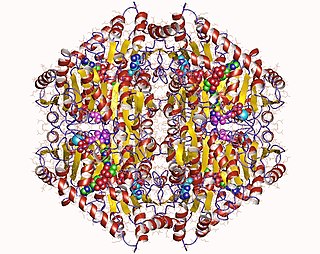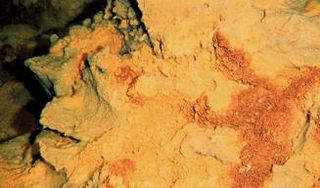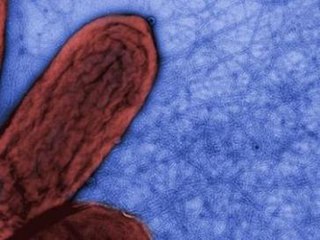
Cytochromes P450 are a superfamily of enzymes containing heme as a cofactor that mostly, but not exclusively, function as monooxygenases. In mammals, these proteins oxidize steroids, fatty acids, and xenobiotics, and are important for the clearance of various compounds, as well as for hormone synthesis and breakdown. In 1963, Estabrook, Cooper, and Rosenthal described the role of CYP as a catalyst in steroid hormone synthesis and drug metabolism. In plants, these proteins are important for the biosynthesis of defensive compounds, fatty acids, and hormones.

Geobacter is a genus of bacteria. Geobacter species are anaerobic respiration bacterial species which have capabilities that make them useful in bioremediation. Geobacter was found to be the first organism with the ability to oxidize organic compounds and metals, including iron, radioactive metals, and petroleum compounds into environmentally benign carbon dioxide while using iron oxide or other available metals as electron acceptors. Geobacter species are also found to be able to respire upon a graphite electrode. They have been found in anaerobic conditions in soils and aquatic sediment.

Azotobacter is a genus of usually motile, oval or spherical bacteria that form thick-walled cysts and may produce large quantities of capsular slime. They are aerobic, free-living soil microbes that play an important role in the nitrogen cycle in nature, binding atmospheric nitrogen, which is inaccessible to plants, and releasing it in the form of ammonium ions into the soil. In addition to being a model organism for studying diazotrophs, it is used by humans for the production of biofertilizers, food additives, and some biopolymers. The first representative of the genus, Azotobacter chroococcum, was discovered and described in 1901 by Dutch microbiologist and botanist Martinus Beijerinck. Azotobacter species are Gram-negative bacteria found in neutral and alkaline soils, in water, and in association with some plants.
Methylotrophs are a diverse group of microorganisms that can use reduced one-carbon compounds, such as methanol or methane, as the carbon source for their growth; and multi-carbon compounds that contain no carbon-carbon bonds, such as dimethyl ether and dimethylamine. This group of microorganisms also includes those capable of assimilating reduced one-carbon compounds by way of carbon dioxide using the ribulose bisphosphate pathway. These organisms should not be confused with methanogens which on the contrary produce methane as a by-product from various one-carbon compounds such as carbon dioxide. Some methylotrophs can degrade the greenhouse gas methane, and in this case they are called methanotrophs. The abundance, purity, and low price of methanol compared to commonly used sugars make methylotrophs competent organisms for production of amino acids, vitamins, recombinant proteins, single-cell proteins, co-enzymes and cytochromes.

The enzyme oxalyl-CoA decarboxylase (OXC) (EC 4.1.1.8), primarily produced by the gastrointestinal bacterium Oxalobacter formigenes, catalyzes the chemical reaction

Nitratidesulfovibrio vulgaris is a species of Gram-negative sulfate-reducing bacteria in the Desulfovibrionaceae family. It is also an anaerobic sulfate-reducing bacterium that is an important organism involved in the bioremediation of heavy metals in the environment. Nitratidesulfovibrio vulgaris is often used as a model organism for sulfur-reducing bacteria and was the first of such bacteria to have its genome sequenced. It is ubiquitous in nature and has also been implicated in a variety of human bacterial infections, although it may only be an opportunistic pathogen. This microbe also has the ability to endure high salinity environments, which is done through the utilization of osmoprotectants and efflux systems.

Penicillium chrysogenum is a species of fungus in the genus Penicillium. It is common in temperate and subtropical regions and can be found on salted food products, but it is mostly found in indoor environments, especially in damp or water-damaged buildings. It has been recognised as a species complex that includes P. notatum, P. meleagrinum, and P. cyaneofulvum. Molecular phylogeny has established that Alexander Fleming's first discovered penicillin producing strain is of a distinct species, P. rubens, and not of P. notatum. It has rarely been reported as a cause of human disease. It is the source of several β-lactam antibiotics, most significantly penicillin. Other secondary metabolites of P. chrysogenum include roquefortine C, meleagrin, chrysogine, 6-MSA YWA1/melanin, andrastatin A, fungisporin, secalonic acids, sorbicillin, and PR-toxin.

The class Zetaproteobacteria is the sixth and most recently described class of the Pseudomonadota. Zetaproteobacteria can also refer to the group of organisms assigned to this class. The Zetaproteobacteria were originally represented by a single described species, Mariprofundus ferrooxydans, which is an iron-oxidizing neutrophilic chemolithoautotroph originally isolated from Kamaʻehuakanaloa Seamount in 1996 (post-eruption). Molecular cloning techniques focusing on the small subunit ribosomal RNA gene have also been used to identify a more diverse majority of the Zetaproteobacteria that have as yet been unculturable.
Geranial dehydrogenase (EC 1.2.1.86, GaDH, geoB (gene)) is an enzyme with systematic name geranial:NAD+ oxidoreductase. This enzyme catalyses the following chemical reaction
Unspecific peroxygenase (EC 1.11.2.1, aromatic peroxygenase, mushroom peroxygenase, haloperoxidase-peroxygenase, Agrocybe aegerita peroxidase) is an enzyme with systematic name substrate:hydrogen peroxide oxidoreductase (RH-hydroxylating or -epoxidising). This enzyme catalyses the following chemical reaction
Iron:rusticyanin reductase is an enzyme with systematic name Fe(II):rusticyanin oxidoreductase. This enzyme catalyses the following chemical reaction
β-Copaene synthase is an enzyme with systematic name (2E,6E)-farnesyl-diphosphate diphosphate-lyase . This enzyme catalyses the following chemical reaction

Geobacter sulfurreducens is a gram-negative metal and sulphur-reducing proteobacterium. It is rod-shaped, aerotolerant anaerobe, non-fermentative, has flagellum and type four pili, and is closely related to Geobacter metallireducens. Geobacter sulfurreducens is an anaerobic species of bacteria that comes from the family of bacteria called Geobacteraceae. Under the genus of Geobacter, G. sulfurreducens is one out of twenty different species. The Geobacter genus was discovered by Derek R. Lovley in 1987. G. sulfurreducens was first isolated in Norman, Oklahoma, USA from materials found around the surface of a contaminated ditch.

1-Hydroxyphenanthrene is a phenanthrol and a human metabolite of phenanthrene that can be detected in urine of persons exposed to PAHs.

Cunninghamella echinulata is a fungal species in the genus Cunninghamella. It is an asexually reproducing fungus and a mesophile, preferring intermediate temperature ranges. C. echinulata is a common air contaminant, and is currently of interest to the biotechnology industry due to its ability to synthesize γ-linolenic acid as well as its capacity to bioconcentrate metals. This species is a soil saprotroph that forms rhizoids, preferring soils enriched in nitrogen, phosphorus and potassium. It has been reported occasionally an agent of mucormycosis following the inhalation of fungal spores. Czapek's agar is a suitable growth medium for the propagation of C. echinulata.
Methylophaga thiooxydans is a methylotrophic bacterium that requires high salt concentrations for growth. It was originally isolated from a culture of the algae Emiliania huxleyi, where it grows by breaking down dimethylsulfoniopropionate from E. hexleyi into dimethylsulfide and acrylate. M. thiooxydans has been implicated as a dominant organism in phytoplankton blooms, where it consumes dimethylsulfide, methanol and methyl bromide released by dying phytoplankton. It was also identified as one of the dominant organisms present in the plume following the Deepwater Horizon oil spill, and was identified as a major player in the breakdown of methanol in coastal surface water in the English channel.

Microbial oxidation of sulfur is the oxidation of sulfur by microorganisms to build their structural components. The oxidation of inorganic compounds is the strategy primarily used by chemolithotrophic microorganisms to obtain energy to survive, grow and reproduce. Some inorganic forms of reduced sulfur, mainly sulfide (H2S/HS−) and elemental sulfur (S0), can be oxidized by chemolithotrophic sulfur-oxidizing prokaryotes, usually coupled to the reduction of oxygen (O2) or nitrate (NO3−). Anaerobic sulfur oxidizers include photolithoautotrophs that obtain their energy from sunlight, hydrogen from sulfide, and carbon from carbon dioxide (CO2).

Diphenic acid, also known as Dibenzoic acid, is an organic compound with the formula (C6H4CO2H)2. It is the most studied of several isomeric dicarboxylic acids of biphenyl. It is a white solid that can be prepared in the laboratory from anthranilic acid via the diazonium salt. It is the product of the microbial action on phenanthrene.
Cytochrome P450, family 105, also known as CYP105, is a cytochrome P450 monooxygenase family in bacteria, predominantly found in the phylum Actinomycetota and the order Actinomycetales. The first three genes and subfamilies identified in this family is the herbicide-inducible P-450SU1 and P-450SU2 from Streptomyces griseolus and choP from Streptomyces sp's cholesterol oxidase promoter region.
Cytochrome P450 family 154 subfamily C member 3 is an actinobacterial Cytochrome P450 enzyme originally from Streptomyces, which catalyzes the 16α-hydroxylation of various steroids.











